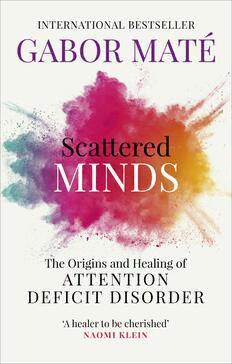
Scattered Minds: The Origins and Healing of Attention Deficit Disorder PDF
Preview Scattered Minds: The Origins and Healing of Attention Deficit Disorder
Praise for Scattered Minds “[Gabor Maté] challenges the standard view of [and] asks questions ADD that deserve to be considered about a debilitating disorder — and the kind of society in which it flourishes.” Maclean’s “Enlightening and sensitively told [with] a much needed focus on adults and adolescents with .… For someone who is wondering if ADHD their own lack of attention, impulsiveness, distractibility, or hyperactivity may be , this would be a good read.” ADHD Winnipeg Free Press “Scattered Minds comes across as a caring, sympathetic, supportive, and helpful introduction to the topic. It also benefits from being an extremely well-written and engaging read.” e Georgia Straight “is book will be equally at home on the physician’s bookshelf [and] in the home.” e County Chronicle “Scattered Minds [is] necessary reading for anyone who lives with the effects of , in himself or in others; it’s an encouraging and reassuring ADD approach.” e Chronicle-Journal (under Bay) “is delightful, helpful book is a welcome addition to the literature on . Based on solid research and a strong humanistic sensibility, it is ADD written with humour and compassion, from an unsparingly honest personal perspective, I would enthusiastically recommend Scattered Minds to anyone touched by — adults, parents, and professionals.” ADD Dr. John Ratey, co-author, Driven to Distraction and Shadow Syndromes 1 2 3 VINTAGE CANADA EDITION, 2000 Copyright © 1999 by Gabor Maté All rights reserved under International and Pan-American Copyright Conventions. Published in Canada by Vintage Canada, a division of Random House of Canada Limited, in 2000. First published in hardcover in Canada by Alfred A. Knopf Canada, Toronto, in 1999. Distributed by Random House of Canada Limited, Toronto. Canadian Cataloguing in Publication Data Maté, Gabor Scattered minds : a new look at the origins and healing of attention deficit disorder eISBN: 978-0-307-37469-1 1. Attention-deficit hyperactivity disorder — Popular works. 2. Attention-deficit disorder in adults. 3. Maté, Gabor — Mental health. 4. Attention-deficit hyperactivity disorder — Patients — Canada — Biography. I. Title. RJ506.H9M37 1999a 616.8589 C99-931480-7 ′ v3.1 4 For my mother, Judith (Lövi) Maté, and for my late father, Andor Maté, and for my own family, Rae, Daniel, Aaron and Hannah 5 Action has meaning only in relationship and without understanding relationship, action on any level will only breed conflict. e understanding of relationship is infinitely more important than the search for any plan of action. —. J KRISHNAMURTI 6 Contents Cover Title Page Copyright Dedication Epigraph Acknowledgments Author’s Note Introduction e Nature of Attention Deficit Disorder PART ONE 1 So Much Soup and Garbage Can 2 Many Roads Not Traveled 3 We Could All Go Crazy 4 A Conflictual Marriage: and the Family (I) ADD 5 Forgetting to Remember the Future How the Brain Develops and How the PART TWO Circuits and Chemistry of Arise ADD 6 Different Worlds: Heredity and the Environments of Childhood 7 Emotional Allergies: and Sensitivity ADD 8 A Surrealistic Choreography 9 Attunement and Attachment 10 e Footprints of Infancy e Roots of in Family and Society PART THREE ADD 11 An Utter Stranger: and the Family (II) ADD 12 Stories within Stories: and the Family (III) ADD 13 is Most Frenetic of Cultures: e Social Roots of ADD 7 e Meaning of Traits PART FOUR ADD 14 Severed oughts and Flibbertigibbets: Distractibility and Tuning Out 15 e Pendulum Swings: Hyperactivity, Lethargy and Shame e Child and Healing PART FIVE ADD 16 It Ain’t Over Till It’s Over: Unconditional Positive Regard 17 Wooing the Child 18 Like Fish in the Sea 19 Just Looking for Attention 20 e Defiant Ones: Oppositionality 21 Defusing Counterwill 22 My Marshmallow Caught Fire: Motivation and Autonomy 23 Trusting the Child, Trusting Oneself: in the Classroom ADD 24 Always on My Case: Teenagers e Adult PART SIX ADD 25 Justifying One’s Existence: Self-Esteem 26 Memories Are Made of is 27 Remembering What Didn’t Happen: e Relationship ADD 28 Moses Saved by the Angel: Self-Parenting (I) 29 e Physical and Spiritual Environment: Self-Parenting (II) 30 In Place of Tears and Sorrow: Addictions and the Brain ADD 8 Conclusion PART SEVEN 31 I Never Saw the Trees: What Medications Can and Cannot Do 32 What It Means to Attend Notes Bibliography 9
